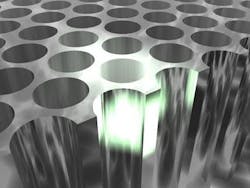MESA+ researchers observe "sub-Bragg" diffraction in photonic crystals
Enschede, The Netherlands--Just about everyone in the know believes that the lowest-frequency (longest-wavelength) stopgap in a Bragg reflector occurs for a distance between Bragg planes of a half-wave (the first-order Bragg condition).1 But researchers at the University of Twente have discovered, by experimentation with photonic crystals, that this is not always the case. They have discovered a prominent stopgap occurring at a frequency below the first-order Bragg condition, which they call sub-Bragg diffraction.
The researchers, in the Complex Photonic Systems group at the University of Twente's MESA+ Institute for Nanotechnology and the Foundation for Fundamental Research on Matter Institute for Atomic and Molecular Physics (FOM Institute AMOLF), investigated a 2D photonic crystal with a centered rectangular lattice using reflectance spectroscopy and found prominent diffraction peaks for sub-Bragg and first-order Bragg conditions.
Applies to many crystal structures
Theoretically, the lowest energy (longest wavelength) at which diffraction, and thus an energy dip, can take place has been unshakably fixed for almost a century, as predicted in the so-called Bragg conditions. "According to this theory, successive diffractions take place which, in turn, lead to energy dips," says researcher Simon Huisman. "The striking thing is that this can take place at lower frequencies or energies. And this applies to almost half of all known crystal structures." The University of Twente researchers collaborated with FOM, NWO (Netherlands Organization for Scientific Research)/Vici, Technology Foundation STW/NanoNed and subsidy program Smartmix-Memphis.
The results are applicable to two of the five 2D Bravais lattices and seven out of the 14 3D Bravais lattices. ("Bravais" lattices are all the regular lattices defined by discrete translations of points. Commonly known Bravais lattices that are susceptible to the sub-Bragg condition include centered rectangular, triangular, hexagonal, and body-centered cubic.)
The researchers believe that the results will be useful in new optical switches that rely on a photonic crystal's forbidden band. "Apart from the fact that it will be possible to shift the energy levels in a new way—which is already pretty spectacular—there are additional possibilities for shifting the frequencies in particular directions," says Huisman. "This has important added value."
Perfect holes are important
By creating Bragg planes in silicon with extremely accurately drilled nanoholes, the researchers were able to observe sub-Bragg diffraction, originating from planes diagonal to the usual Bragg planes. The accurate drilling of the holes was essential for the observations. "That is an absolute condition for the observation, because scattering clouds the results irreparably," says Huisman.
Source: http://www.utwente.nl/en/archive/2012/02/new_diffraction_phenomenon_observed_and_explained.doc/
REFERENCE:
1. Simon R. Huisman et al., Physical Review Letters, Vol. 108, Issue 8 (2012); doi: 10.1103/PhysRevLett.108.083901

John Wallace | Senior Technical Editor (1998-2022)
John Wallace was with Laser Focus World for nearly 25 years, retiring in late June 2022. He obtained a bachelor's degree in mechanical engineering and physics at Rutgers University and a master's in optical engineering at the University of Rochester. Before becoming an editor, John worked as an engineer at RCA, Exxon, Eastman Kodak, and GCA Corporation.
